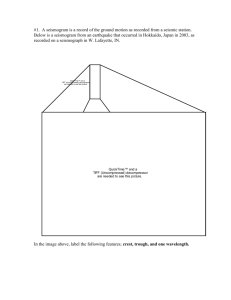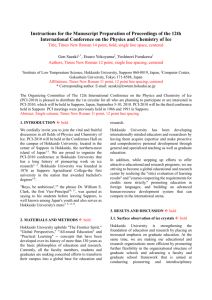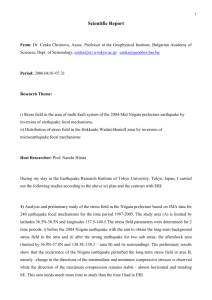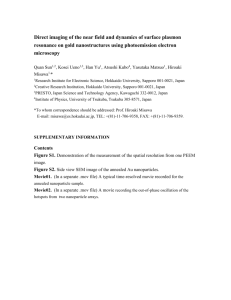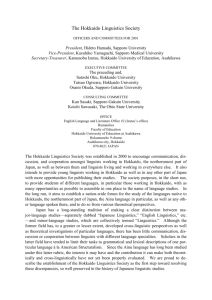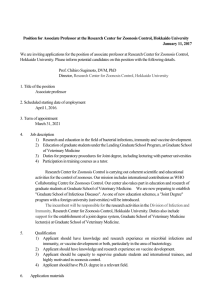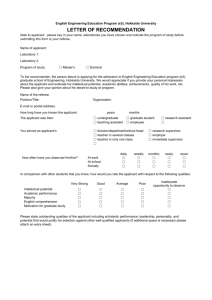echinococcosis multilocular
advertisement
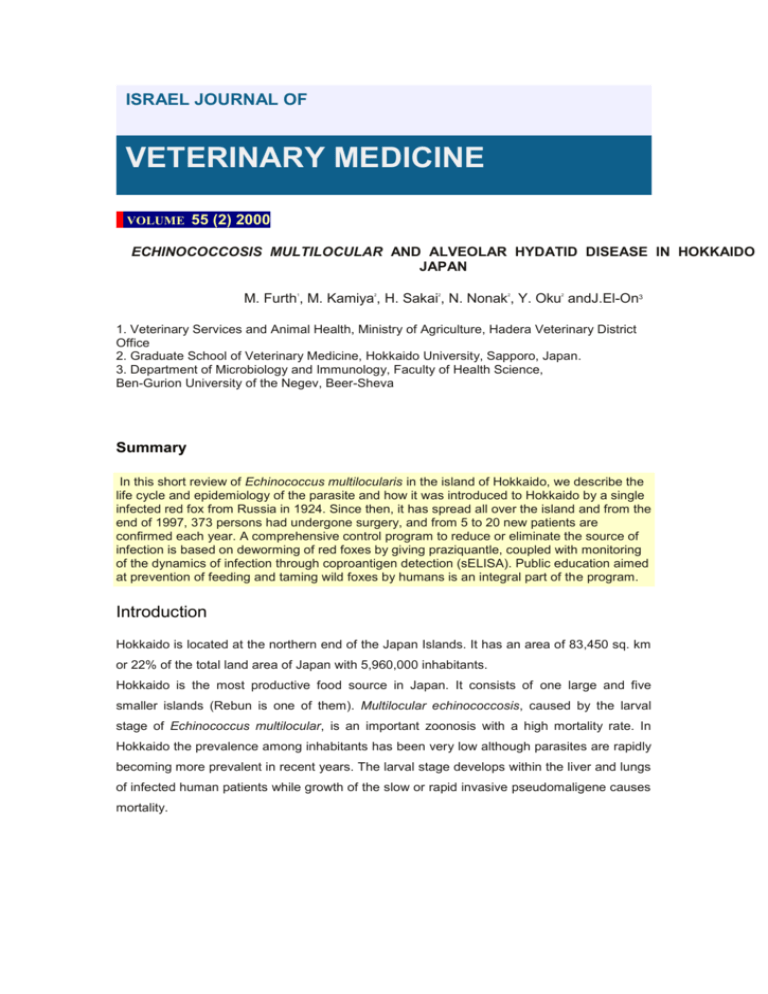
ISRAEL JOURNAL OF VETERINARY MEDICINE VOLUME 55 (2) 2000 ECHINOCOCCOSIS MULTILOCULAR AND ALVEOLAR HYDATID DISEASE IN HOKKAIDO JAPAN 1 2 2 2 2 M. Furth , M. Kamiya , H. Sakai , N. Nonak , Y. Oku andJ.El-On3 1. Veterinary Services and Animal Health, Ministry of Agriculture, Hadera Veterinary District Office 2. Graduate School of Veterinary Medicine, Hokkaido University, Sapporo, Japan. 3. Department of Microbiology and Immunology, Faculty of Health Science, Ben-Gurion University of the Negev, Beer-Sheva Summary In this short review of Echinococcus multilocularis in the island of Hokkaido, we describe the life cycle and epidemiology of the parasite and how it was introduced to Hokkaido by a single infected red fox from Russia in 1924. Since then, it has spread all over the island and from the end of 1997, 373 persons had undergone surgery, and from 5 to 20 new patients are confirmed each year. A comprehensive control program to reduce or eliminate the source of infection is based on deworming of red foxes by giving praziquantle, coupled with monitoring of the dynamics of infection through coproantigen detection (sELISA). Public education aimed at prevention of feeding and taming wild foxes by humans is an integral part of the program. Introduction Hokkaido is located at the northern end of the Japan Islands. It has an area of 83,450 sq. km or 22% of the total land area of Japan with 5,960,000 inhabitants. Hokkaido is the most productive food source in Japan. It consists of one large and five smaller islands (Rebun is one of them). Multilocular echinococcosis, caused by the larval stage of Echinococcus multilocular, is an important zoonosis with a high mortality rate. In Hokkaido the prevalence among inhabitants has been very low although parasites are rapidly becoming more prevalent in recent years. The larval stage develops within the liver and lungs of infected human patients while growth of the slow or rapid invasive pseudomaligene causes mortality. Life cycle and epidemiology of E. multilocularis The natural definitive host is the wild canid, fox and small mammal, and the intermediate hosts are mainly arvicolid and cricetid rodents (Fig. 1). The adult stage, the strobila, occurs in the intestine of foxes, genus vulpes and Aloper, as well as in dogs, coyotes and wolves. Kamiya et al. found that cats could also serve as a definite host (1). The natural cycle is completed through the predator-prey relationship. The prevalence of cestodes in the fox intestine is highest during the autumn following several months of feeding on Voles mirocrotus. In winter, accumulating snow prevents efficient hunting of voles and foxes must utilize other food sources. The fox expels the cestodes during winter (2). E. multilocularis is limited to the northern regions of the world: Europe, Eastern Russia, Alaska, Canada, Hokkaido, but was recently found also in India, Middle East (Turkey), Iran, Tunsia and North Africa. In contrast to E. granulosus, the cestode has very limited genetic variation; E. multilocularis isolates from Germany, Japan, Alaska have identical nucleotide sequences (3). Human prevalence in Hokkaido The first patient with echinococcosis living on Rebun Island was discovered in 1937 at Otaru, 134 patients have been identified as Rebun cases till 1989. The first Kion-sen cases were found in 1968 and 208 patients have been treated until 1979. Since then human cases occur sporadically throughout Hokkaido (4). By the end of 1997, 373 persons had undergone surgery, and 5 to 20 new patients are confirmed each year. In addition about 400 persons each year in Hokkaido are provisionally diagnosed as being infected by imaging and serology (5). Although the prevalence among inhabitants is very low, infestation is rapidly spreading in recent years (Fig 2). Sato et al, (6) investigated responsiveness to treatment and prognosis of the disease with historical comparison of screening systems. The patients were classified in three groups; group A detected by current screening system of enzyme-linked immunosorbent assay and ultrasound since 1984; group B detected by serological screening performed between 1974 and 1984 and group C, non-screened patients diagnosed accidentally. Early lesions are found most frequently in group A. The five years survival rate was 100% in group A, 74% in B and 69% in C, with a significant intergroup difference. The current system favours early diagnosis of the disease, contributing to its responsiveness to treatment and to better prognosis. Nagno et al, (7) investigated the prevalence of human alveolar echinocococcosis in Hokkaido by western blot analysis capable of classifying persons infected with E. multilocularis into two groups: the "complete type" that showed multiple bands of various molecular weights and the incomplete types with a few bands of low molecular weight. From the geographic distribution, those with the complete type first appeared in 1992 in Western Hokkaido. The age distribution indicates that the complete type pattern has increased since 1990 in less than 30 years old. Prevalence and diagnostic methods for foxes and vulpes infected with E. multilocularis in Hokkaido E. multilocularis is believed to have been introduced into Rebun Island by infected red foxes translocated from the middle Kuriles (Russia) during 1924 and 1926. Kamiya and Obayashi found 328 infected red foxes diagnosed at necropsy in the Namura and Kashiro districts of Hokkaido during 1966 to 1973 (8). The distribution tendency of the patients coincides with the explosion of the infection of red foxes with Echinococcus multilocularis in Hokkaido after 1980. In 1985 Kamiya found 10% of foxes infected at necropsy. This increased to 20% in 1992, 39.5% in 1993 and 36.2% in 1997. Detection methods: Coproantigen ELISA performed on fecal samples showed positive results in 38/40 (95%) and 95/97 (97.9%) in 1990 and 1992, respectively. The results suggest that detection of coproantigen is useful in field surveys of naturally infected foxes (9). E. multilocularis coproantigens detection was applied for monitoring the parasite in families of foxes. The results showed that cubbing dens are one of the important endemic foci where intermediate hosts frequently ingest eggs derived from cub feces. Fox breeding dens were found around urban areas. Out of 21 dens in urban areas 13 were coproantigen positive while taenid egg positive feces were also found. These results suggest that the life cycle of E. multilocularis be probably maintained even in the urban area of Sapporo City (10). Prevalence in rodents During May through October 1983, rodents and shrews were caught in Asahikawa and Kushiro districts and examined for echinococcal infection. Of 603 animals examined in Kusiro district, one was positive but no evidence was found in animals from Asahikawa (11) (Fig. 3). In 1992 of 42 rats captured at garbage dumps in southern Hokkaido, one was infected (12). Strategy for controlling E.multilocularis in Hokkaido The distribution of the patients coincided with the explosion of E. multilocularis in foxes in Hokkaido after 1980 (10). The control programs having invariably been aimed to reduce or eliminate the infection in humans. The designed outcome is a satisfactory decrease in prevalence of human cases. A comprehensive control program was started in Hokkaido in 1997. This included deworming of red foxes by administration of praziquantel to foxes in the wild and monitoring its progress with a coproantigen sandwich ELISA performed on fecal samples. A massive education campaign aimed at the population consisted of prevention of feeding or taming red foxes and washing all agricultural products. The coming decades will tell whether the campaign has achieved its goal (13,14). References 1. Kamiya, M., Ooi, H.K. and Ohhagashu, M.: Nippon, Juigaku Zasshi, 48(4): 763-7, 1986. 2. Rausch, R.L., Fay, F.H. and Williamson, S.S.: The ecology of Echinococcosis multilocularis on St. Lawrence Island, Alaska. II. Helminth populations in the definitive host. Ann. Parasitol. Hum. Comp. 65(3): 131-140, 1990. 3. Rimder, H., Rausch, R.L., Takahashi, K., Koop, H., Thomschke, A. and Loscher, T.: Limited range of genetic variation in E. multilocularis. J. Parasitol.: 83(6): 1045-1050, 1997. 4. Minagawa, T.: Survey of echinococcosis in Hokkaido and measures against it. Hokkaido IgakaZashi 72(6): 569-581, 1997. 5. Kaniya, M.: Echinococcosis in Hokkaido: epidemiology and its control. Int. Symposium, Hokkaido Un. Sapporo, August 1998. 6. Sato, N., Uchino, J., Takahashi, M., Aoki, S., Takahashi, H., Yamashita, K., Matsushita, M., Suzuki, K. and Namieno T.: Survey and outcome of alveolar echinococcosis of the liver: historical comparison of mass screening systems in Japan. Int. Surg. 82(2): 20-24, 1997. 7. Nagano, H., Sato, C. and Furuya, K.: Human alveolar echinococcosis seroprevalence by WB in Hokkaido, Japan J. Med. Sc. Biol. 48(3): 157-61, 1995. 8. Nonaka, N., Tsukada, H., Abe, N., Oku, Y. and Kamiya, M.: Monitoring of Echinococcus multilocularis infection in red foxes in Shiretoko, Japan, by coproantigen detection. Parasitol. 117: 193-200, 1998. 9. Sakai, H., Nonaka, N., Yagi, K., Oku, Y. and Kaniya, M.: Coprantigen detection in survey multilocularis infection among red foxes, Vulpes schencki in Hokkiado, Japan. J. Vet. Med. Sci. 60(5): 639-641, 1998. 10. Kimura, H., Furuya, K., Kawase, S., Sato, C., Yamano, K., Takahash,i K., Uraguchi, K., Ito, T., Yagi, K. and Sato, N.: Recent epidemiologic trends in alveolar echinococcosis prevalence in humans and animals in Hokkaido. Jpn J. Infect. Dis. 52(3): 117-20, 1999. 11. Inaka, T., Ohnishi, K. and Kutsumi, H.: Detection of echinococcal infection in rodents and shrews caught in Asahikawa and Kushiro districts. Hoddaido Igaku Zusshi (9): 728-733, 1984. <p class="Ms
